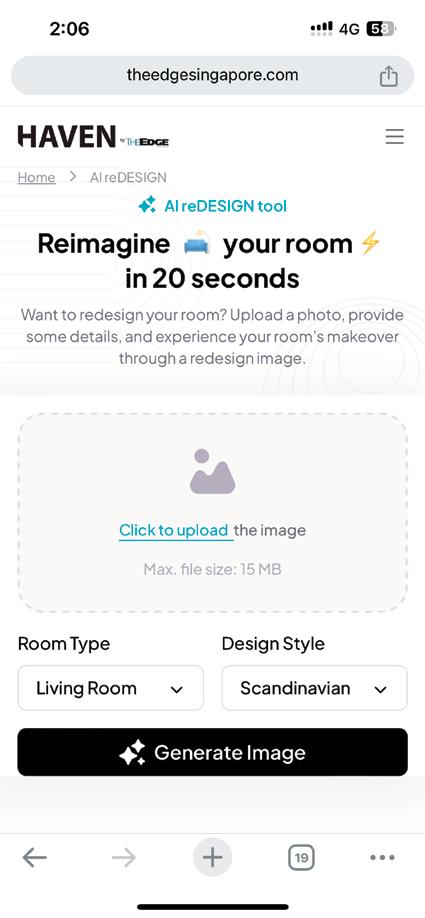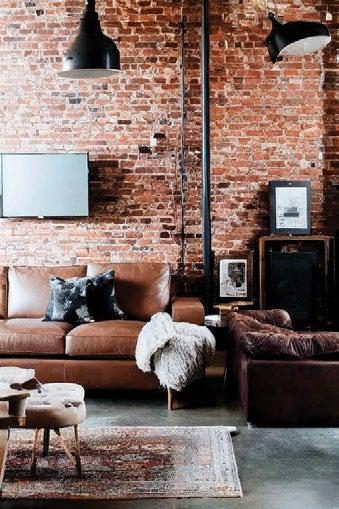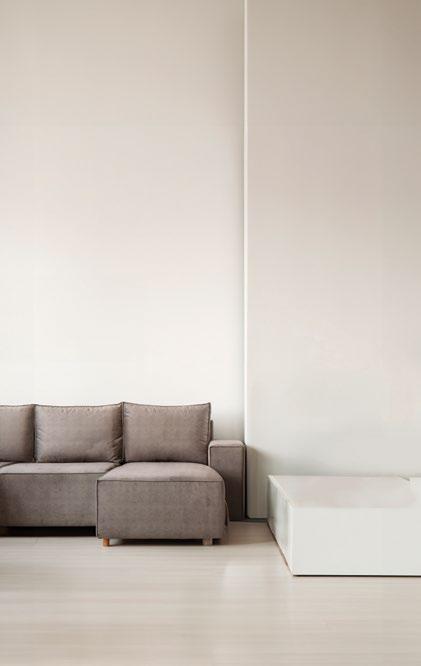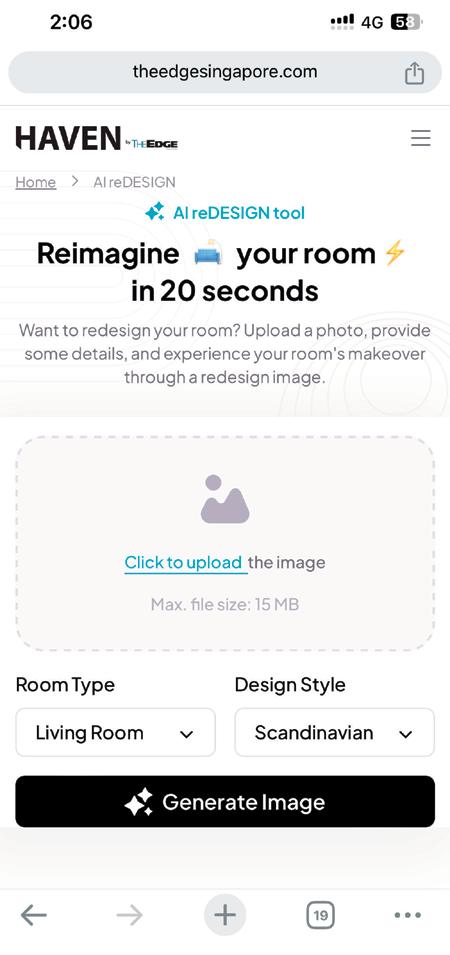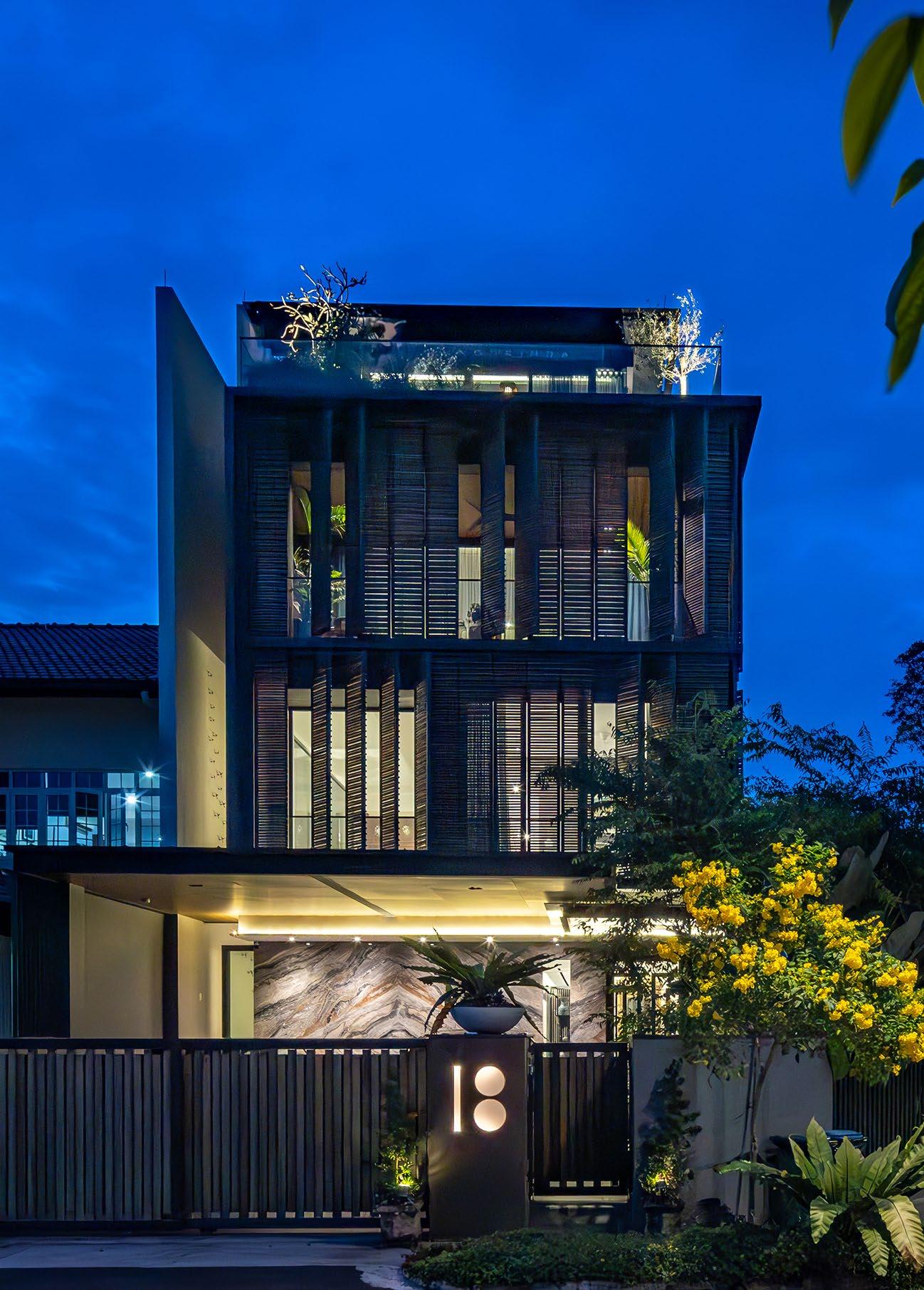

NESTING IN NATURE
Surrounded by plants and framed by recycled wooden slats that bathe the interiors in light, this new home is perfectly at one with the great outdoors
ECO LIVING IN STYLE
BY AUDREY SIMON audrey.simon@bizedge.com
Sustainable homewares for a greener home
Enhance the eco-friendliness of your home by decorating it with sustainable homewares made to minimise environmental impact and champion sustainability. These products are fashioned from eco-conscious materials, recycled or upcycled resources, or manufactured using practices that lower energy usage and waste. Our curated selection includes furniture, textiles, decor, kitchenware, and various household essentials produced with an emphasis on environmental consciousness and durability.

Net-a-Porter
Savyavasa
For those seeking modern sustainable living, Savyavasa in South Jakarta is the ultimate choice. Developed by JSI Group and Swire Properties, this luxury residential project boasts interiors crafted by three talented Indonesian designers: Yuni Jie, Eko Priharseno, and GondoJules. Their collaborative effort embodies a dedication to creating sophisticated and practical living spaces that prioritise modern sustainable living.


Explore the Net Sustain collection on Net-a-Porter, providing a thoughtfully curated selection of consciously crafted, enduring luxury items spanning fashion, jewellery, beauty, and homewares.

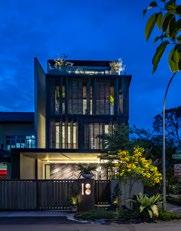
Bolia
Crafted with a focus on durability and luxurious craftsmanship, Bolia’s 2024 Spring Collection introduces a unique feature for many of its indoor and outdoor sofas: changeable covers. This innovation allows you to easily refresh and renew your designer sofa multiple times. Explore the tailored sofa series, characterised by handcrafted details and covers that are fully removable and changeable, making maintenance effortless and ensuring long-lasting quality. Bolia’s latest collaboration with Danish traceable leather brand, Spoor, brings Quattro by Spoor, an eco-friendly and biodegradable chrome-free leather. Each piece of this leather is traceable from the farm to the final product, sourced exclusively from Danish and Swedish cows. The leather is transformed into a luxuriously soft material at Denmark’s last remaining tannery situated on the picturesque island of Funen.

Eco-Mate
Discover the convenience of green-friendly cleaning products with just a click at https://veo.world. There, you can explore Eco-Mate cleaning products, made in the UK and packaged in 100% plastic and metal-free paper bottles. These unique paper bottles are not only plastic-free but are also crafted from a by-product that would have otherwise gone to waste.
The Eco-Mate range of cleaning products is a plant-based laundry liquid made from natural, plant-derived components, free from enzymes and optical brighteners. These products are available in hypoallergenic fragrance-free options or with 100% pure natural essential oils, providing a fresh and clean scent without harsh chemicals. The formulas are also paraben and phthalate-free, reflecting a commitment to safer and eco-friendly cleaning solutions.
While shopping for these items, consider exploring the Invigorate diffuser by By Lula, which shares the same refreshing scent profile as the candle that is part of the wellness collection. These complementary diffusers are designed to uplift with a zesty citrus aroma, providing the perfect boost to start your day.
Mud Australia
Rescued Rose collection is a limited edition line made from rescued clay from porcelain trimmings, spills, and broken greenware generated during the production process. The material, known as “rescued clay”, is collected, filtered, and aged before being utilised to create new products.

In its commitment to eco-conscious practices, Mud Australia has implemented various initiatives to reduce its environmental impact. Its slip casting process has been optimised by incorporating water-saving measures, including internal rain tanks and a rigorous water filtration system, ensuring that water discharged from the studio remains clean and eco-friendly.
Moreover, Mud Australia has transitioned to sourcing all its electricity from renewable sources and has installed a 100kW solar system on their studio roof. It embraces energy-efficient practices by employing LED lighting throughout its premises and utilising excess kiln-produced heat to dry moulds and products. The company also upcycles all leftover materials, remoulding fired porcelain seconds and transforming broken pieces into zero-waste Terrazzo products, thus minimising waste generation.
Roger&Sons
A family business, furniture maker Roger&Sons is handled by three brothers — Morgan Yeo, a business graduate from Singapore Management University, oversees business strategy and development; his youngest brother Ryan, 27, manages operations and is a carpenter, while the middle brother Lincoln, 31, is pursuing a career in filmmaking and occasionally consults on branding and creative direction matters.

The brothers took over the business, initially known as JR & P Industries, from their father Roger Yeo in 1999. After their father’s pancreatic cancer diagnosis in 2014, they decided to revamp the business to keep up with the changing market. They rebranded it as Roger&Sons and shifted focus to creating custom-made furniture in small batches, thus preserving the craftsmanship of long-time artisans.
One of Roger&Sons’ core principles is sustainability, reflected in their Local Tree Project started in 2019. By sourcing local materials like Angsana, Khaya, and Raintree, they aim to reduce their carbon footprint and promote eco-friendly production methods. Despite challenges like longer processing times and higher costs for in-house treatment of wood, they prioritise sustainability over convenience.
To promote environmental responsibility in the furniture industry, Morgan emphasises the importance of ethical practices throughout the entire supply chain. Roger&Sons conducts workshops to educate the community about woodworking, aiming to elevate carpentry to an art form. They prioritise responsible sourcing, fair treatment of suppliers, and engaging with various community groups to spread awareness about their craftsmanship and sustainability efforts.
Earth Hero
Make the sustainable choice by replacing single-use paper towels with this eco-friendly organic alternative. Not only does this transition conserve trees and water, but it also saves you money in the long run.

Crafted from GOTS (a textile processing standard for organic fibres) or certified organic cotton, our reusable 1-ply paper towels offer a solution for various cleaning needs, from spills to hand drying. After use, simply toss them in with your regular laundry, allowing you to reuse them for years to come. Due to the natural properties of cotton, these towels conveniently stick together, facilitating easy rolling back onto the cardboard towel tube.
Select from the 12-pack folded option or the 24-pack pre-rolled set, available in earth tones, greys, or white. Note that these towels become more absorbent with each wash. Prior to use, rinsing and wringing the towels may improve their absorption capacity.
Available at https://earthhero.com/collections/home/products/reusable-paper-towels.
Jungle Culture
Jungle Culture is dedicated to producing top-quality natural homeware for eco-conscious households. The majority of its zero-waste household essentials are crafted from chemical-free, organic wood, and other eco-conscious natural resources.
Immerse yourself in the beauty of Jungle Culture’s eco-friendly coconut bowls and spoons, skillfully handmade by artisans in Southern Vietnam. Sustainable buddha bowls are available in five different eco styles, each crafted from organic coconut shells. Do note that due to their natural origins, the size and shape of each coconut bowl and
spoon set may vary slightly, hence adding a unique charm to every piece.
One set contains:
2 x Eco-friendly Coconut Bowls
2 x Reclaimed Wooden Spoons
• 1 x Jungle Straw (Bamboo Straw)
1 x Coconut Fibre Straw Cleaning Brush
1 x Natural Jute Straw Sleeve
Discover Jungle Culture’s collection of sustainable homewares, handcrafted from eco-friendly bamboo, upcycled coconut shells, and reclaimed materials at https://jungleculture.eco/collections/ sustainable-homeware.

Transform your home into an eco-friendly haven, starting from your kitchen essentials like the Arthur Zaaro hand-crafted chopping board. Made from sustainably sourced urban wood, these unique boards are crafted to ensure they never come apart. Their dual-sided design allows for versatile use — one side for chopping and the other for serving and hosting guests. Featured here is the Carving Board #587 (34 x 25 x 3 cm), meticulously crafted from solid blocks of African Mahogany sourced from the Changi region. Known for its rich tones and unique grains, African Mahogany exudes elegance and sophistication. Each board in this collection has been carefully dried and aged, guaranteeing durability akin to fine wine — seasoned, dried, and designed to withstand the test of time.
Visit the showroom at 122 Eunos Avenue 7, Richfield Industrial Centre #08-07, Singapore 409575, or check out the website at https://arthurzaaro.com/ shop-cutting-boards.

Arthur Zaaro
One with nature
Creative passive design, an eye on sustainability and sleek aesthetic choices seamlessly blend a slice of the great outdoors in this home
BY RUSSELL SOH russell.soh@bizedge.com
Integrating greenery at home is never easy, even when working with larger spaces. One runs the risk of having just a few scant potted plants lying about in favour of more living space, or going the other extreme and turning an abode into a jungle.
The challenge becomes yet more complicated when dealing with an oddshaped piece of land, which limits how a building can be shaped. For Mark 12 Architects, designing such a home — on a triangular plot, no less — required creativity and a knack for balancing function with form.
“When the client approached us, I got very excited,” says principal architect Clement Koh, describing his initial thoughts about the project. The brief, he recounts, was straightforward enough: create a dwelling that could accommodate the client’s multigenerational family, with sufficient space to garden for the plant lovers among them.
But executing that brief, given the constraints of the space, was far from simple. “This being a triangular plot, the challenge was to match the client’s requirements while allowing parts of nature to be integrated,” says Koh. “We wanted to encapsulate the idea of a home with a sense of openness, connection to the outdoors and nature, and something that is site-specific.”
The solution he devised to accommodate the family’s spatial needs was to add a mezzanine between the first and second levels of the house. With a music room and bedroom on one end, and an open lounge area on the other, the mezzanine adds floor area without compromising light and airflow in the first level’s living room, dining area and dry kitchen.
Next, to incorporate greenery, Koh designed a set of 15 balconies. Each of the six bedrooms has its own attached “pocket garden”; some extend across two levels, breaking away from the “layered” structure of a typical house with strict stratification between floors.



Additional balconies at the common areas on the upper levels provide yet more space for nature; the one on the attic-level entertainment room has even been converted into a koi pond.
One benefit of having so many open spaces — especially in such a densely built home — is the creation of breezeways, which allow air to flow through different parts of the house for a cooling effect.
“There are various openings for wind to penetrate, and because of that cross-ventilation, the house ‘breathes’,” Koh explains. At the same time, overhanging balconies provide shade for the lower levels. All this reduces the need for cooling by means such as air-conditioning.
Such passive design, Koh adds, is a key part of sustainable home design. “At the core of the design, planning must be

done so that minimal energy is expended on cooling and daylighting.”
Once the architectural aspects of the house were set in stone, the Mark 12 team next turned its attention to interior design. With so many different rooms created, it was important to maintain a sense of harmony and unity, says Koh. “We wanted to keep a smaller palette for this house,” he adds.
Design manager Varian Chang, who also worked on the project, focused on finishings to tie the house together. Light, warm tones — whites, beiges, greys and tans — create a flow throughout the various spaces, making them feel wider and airier.
Laminates were used to add texture to surfaces while extending the colour scheme. Having used Lamitak products in past projects, Koh and Chang knew they would work well in this house. “We’ve received good feedback from clients regarding its durability, and the customer service has been fantastic,” Koh explains.
Working with the client, they narrowed their picks to two: the Aria Laurentian Maple (WY 5605D) and Smoke Microcement (DXP 1393MD). These were applied all around the house, from the dry kitchen to the bathrooms and the entertainment room.
The result is a consistency that unifies the house without compromising on visual interest. The pale hues make for



a clean backdrop that reflects light exceedingly well, supported by subtle textures that hold their own when viewed up close.
Explaining the choice of laminates, Chang says the tone and grain of the Aria Laurentian Maple fit well with the client’s desire for a Japandi-style interior. The Smoke Microcement, meanwhile, was introduced to “give some character to the space”, while subtly contrasting against the adjacent textures and colours throughout the house.
Speaking on what sets a good laminate apart from others, Koh points out that besides technical performance, aesthetic appeal is key. “The colour, grain and texture have to speak in an emotive manner to the designer and end-user, to create that pleasing effect,” he says.
He adds that Mark 12 has continually found success with Lamitak, especially thanks to the wide variety of its products. The brand’s range includes textures from wood to stone and marble, giving homeowners and interior designers plenty of options — not to mention sources of inspiration.
Lamitak’s sustainability credentials are another plus point, Koh notes. The brand’s laminates have been certified under the Singapore Green Labelling Scheme in recognition of their minimal effects on the environment; they have also received the UL Greenguard certification for
chemical emissions.
low toxic
MARK 12 ARCHITECTS
Mark 12 Architects design manager Varian Chang (left) and principal architect Clement Koh worked on the house
“Pocket garden” balconies provide spaces for gardening while allowing for passive cooling throughout the house MARK 12 ARCHITECTS Lamitak laminates were applied to cabinets and other surfaces throughout the house
Lamitak’s Aria Laurentian Maple and Smoke Microcement are great reflectors of light, making the house feel brighter and roomier
The subtly contrasting textures of Lamitak’s Aria Laurentian Maple and Smoke Microcement add visual interest to the house
CHUA/THE
A well-ventilated mezzanine adds floor area without compromising light and airflow

GREEN? WHAT MAKES A HOME
Two experts share their perspectives of a “green” home as a living space that prioritises environmental friendliness and sustainability to minimise its impact on the environment and human well-being
BY CHIARA CALUFETTI-LIM AND PAOLO DE SIMONE


The “green” word used today is a multifaceted term that is used to embody the principles of sustainability and environmental stewardship, with the ultimate goal of prioritising the long-term well-being of the planet and its inhabitants.
At WATG, we view being green beyond just environmental decisions. We consider factors such as holistic wellness that extends from dwellers to staff, preservation and enhancement of the site, engagement with the local community such as with local artisans and artists to ensure their craft, culture and heritage are celebrated and continued, as well as delivery of long-term client success as part of being sustainable.
It is about striking a delicate balance between environmental resilience, social responsibility, and economic viability, to ultimately achieve harmony between humans and the greater natural world.
A crossover phenomenon between hospitality and residential design is happening today as hotels inject the essence of home into their property to cater for multigenerational stays and extended bleisure travels while homes are designed to provide a getaway retreat experience.
For our recently launched project Umana Bali LXR, our architecture, landscape architecture studios and Wimberly Interiors came together to transform an existing 72-villa clifftop resort into Southeast Asia’s first LXR Hotels & Resorts property. We looked to the profound local philosophy Tri Hita Karana — harmony with the divine, with people and with nature, as our source of inspiration. This philosophy is a cornerstone of Balinese culture and has been widely attributed as a way to balance the agenda of economic growth with cultural preservation and environmental protection to ensure the well-being of both the Balinese people and their island home.
With over three decades of experience in Bali resort design, we found this philosophy to be the exemplar of being green and deeply resonant. Some of the renovation strategies we executed were the preservation of existing structural columns and foundation, and revitalising key pieces of the existing property. These strategies maximise economic efficiencies in the property’s enhancement by reducing costs associated with building new and most importantly minimising waste.
Leveraging on our years of expertise in hospitality design, our lens to residential and home designs is guided by our hospitality ethos based on the core tenets of welcome, warmth, memorability, and restoration. We design and conceive a green home in a similar approach we would for a green resort.

The building and construction sector is responsible for 37% of global emissions. As responsible designers, we understand the critical role we play and often ask ourselves “Do we have to build new?”, “What can we conserve and repurpose?”.
Prioritising renovations and transformation of existing built forms will contribute significantly to being green. We propose as much as possible using materials with less embodied carbon, repurposing existing site materials as much as possible for renovation projects and deploying a regenerative approach to reduce impact and preserve biodiversity. In fact, this is part of the “WATG Way” of design that we practice on our projects — a nod to our founders’ legacy of pushing boundaries of possibility since our dawning days in 1945.
By consciously responding to the residential development’s site location, we design architectural forms that are shaped by orientation, daylight and natural ventilation considerations. Intrinsically linking design solutions to the site results in maximised opportunities for passive and sustainable strategies to be incorporated from the onset, in addition to other known advantages such as maximising views of the outdoors to induce serenity and tranquillity.
Biophilic design is an
approach we champion, first led by our founder Pete Wimberly and reflected in many of our projects. It emphasises the importance of integrating natural elements into the built environment to foster a deep connection between humans and nature for overall well-being. Key elements of biophilic design include vegetation, natural light, and sensory engagement.
Vegetation, such as indoor plants and botanical wall coverings, is central to biophilic design because it enhances positive feelings and accelerates recovery from stress. Ample access to sunlight is crucial as it helps regulate circadian rhythms and boosts mood. Passive heating and cooling, achieved through natural ventilation and strategic shading, contribute to comfort and energy efficiency. Sensory engagement, through natural textures like wood and stone, and elements like water features, creates a holistic experience that nurtures the innate humannature interaction.
As humans, we continuously aspire to be healthier, more mindful and aligned with being present. As designers, we have to think beyond just green walls or catering ample fitness amenities but how the overall space touches and feeds holistically into our well-being, the mind, and the soul. We need to design
for well-being from the start by thinking of how the users will use the space and bring in every healing opportunity that goes beyond aesthetics and functionality. For urban dwellers, incorporating biophilic design can be as simple as repositioning furniture to maximise views of nature, using indoor plants as room dividers, creating small herb gardens, or simply dedicating spaces to centre oneself for mindfulness pursuits. These intentional choices not only improve aesthetic appeal but also promote relaxation and well-being, making biophilic design an essential aspect of modern interior design. We design spaces to lift the spirits. Through the medium of design, stories can be narrated to form an emotional bond with the dwellers. At the end of the day, a home should be green and above all, serve to bring joy to our everyday.
Founded in Honolulu in 1945 by George “Pete” Wimberly, WATG is an integrated design firm with five studios — Advisory, Master Planning, Architecture, Landscape Architecture and Wimberly Interiors, designing spaces that respect, protect and enhance the natural magic of their surroundings while delivering long-term value for clients and communities. Chiara Calufetti-Lim is principal & studio director of architecture at WATG. Paolo De Simone is creative director of Wimberly Interiors

PARTNERSHIP CREATIVE
BY AUDREY SIMON audrey.simon@bizedge.com
Enhancing design solutions with innovation for a more impactful design experience
When JUNG, a pioneer in modern building technology, collaborates with QUADE, a versatile design firm spanning residential, commercial, hospitality and retail sectors, a magical creative synergy emerges.
QUADE’s methodology centres on forward-thinking principles that nurture both creativity and utility. Their core philosophy celebrates the art of intricate craftsmanship, often hidden beneath seemingly simple surfaces. They firmly believe that every space should be meticulously planned, customised to its intended use, and cherished by those who inhabit it.
Since its inception in Germany in 1912, JUNG has led the way in modern building technology. A family-owned enterprise, JUNG has crafted a diverse range of automation systems for lighting, blinds, air conditioning, security, and beyond. Revered for their innovation and exactness, JUNG products blend technical expertise with timeless design seamlessly. Their solutions are sought by prominent architects and interior designers worldwide, gracing prestigious locations such as the Hermitage Museum in St Petersburg and the Shangri-La Hotel in Singapore.
In this discussion, we delve into the collaboration between QUADE’s Creative Director, Billy Pang, and JUNG, focusing on technology’s pivotal role in meeting client sustainability objectives.
Could you share the story of how your design company was founded? What inspired you to delve into smart, sustainable living?
QUADE was founded by three individuals from different walks of life with a vision — to provide excellent design solutions to our clients, enhancing their lifestyle experiences. We have been offering our services since 2010. Sustainable design aims to create spaces that positively impact our climate, environment and society. This allows us to not only bring awareness but to also cofound an understanding of how crucial the role of designing plays into sustainability, environmental impacts and climate change.
Can you expand on your design philosophy and how JUNG’s smart solutions support it?
Design should be timeless and evolve through form, feeling, and function. It establishes a core set of beliefs about quality, integrity, and employs a system of standards to further push our designs while still fulfilling our client’s needs within the space.
The smart solutions provided by JUNG have inspired our designs with the experience of better solutions for a more comfortable living experience. Whereby evolving the space to provide more comfort and ease in our client’s home with simplicity and lifestyle.
Could you tell us about some projects you are particularly proud of and where JUNG products were instrumental in the design?
There was a specific project in Kelantan where we chose the JUNG LS 990 Les Couleurs ® Le Corbusier series and JUNG KNX Systems. ISwitches are often an afterthought to interiors; however, in this case, we made it a beautifully crafted statement piece that complements home automation for practicality and elegance.
Paired with both functionality and aesthetics, it enhanced the project’s design to feel unique and beautiful while still being simple and elegant. The range of colour choices brings forth a vast variety of design possibilities, challenging us to play around and develop a design most suitable for the given space.
What design challenges do you face as an interior designer in today’s market, and how do you address them?
The challenges, I would say, lie in providing solutions that are constantly evolving due to changes in aspects of life, technological advancements, and adaptation to society’s demands and needs. Therefore, as solutions providers, we must be versatile and adapt to new ideas. We must continue to search for new suppliers to ensure better quality products that enhance our designs. This involves conducting careful research into the use of recycled, recyclable, natural, and low-impact materials


A unique partnership forms when a building tech leader JUNG, teams up with a versatile design firm like QUADE
Pang: The goal of sustainable design is to create spaces that positively impact our climate, environment and society
that are also highly durable to increase the product lifecycle.
Do you think JUNG’s range of smart home solutions complements the textures, colours and materials you typically use in your designs?
From being a fan to a follower, I truly believe in the products and services that JUNG provides.
I found it a relatively simple and well-designed product that fits every aspect. From form to function and feeling, it meets all the requirements to offer complete design solutions. With their innovative and accommodating systems, I believe that working with JUNG has been providing us a chance to fulfil our visions of providing simplicity in work and life. Working together with them has proven that our vision is no mere dream, but made into reality through JUNG’s technological advancement and systems.
Are there any smart home design trends that excite you, and how have JUNG products helped you incorporate these trends into your work?
Pairing technology with design in this era is always challenging, especially when automation is seen as the new norm. Being an interior designer, I place a lot of emphasis on statement pieces within each space. Take switches for example. Small and even trivial when compared to other interiors. Yet, such a minor component can be where we could project creativity in the space.
What I mean is that a switch should not just look good; it needs to play a part in practicality, which is why I love working with brands like JUNG. Their switches have the right tactile feel and come in a variety of genuine metals and colours. I especially love the JUNG LS 990 Les Couleurs ® Le Corbusier range, and when paired with the JUNG KNX Systems, it provides the ultimate solution for the final touch of my design. This is what gets me excited, brands that understand our clients’ needs.
How have JUNG solutions offered distinctive experiences or functionality in the homes you have designed?
In the most human way possible, JUNG solutions aim to cater to humanity’s need to adapt to evolving technologies. It effortlessly guides people to live adaptively, paving the way for future-proof lifestyles to evolve into sustainable growth for generations to come.
How do you combine traditional design with modern technology in homes, and could you provide an example of how JUNG products have facilitated this blend?
In modern society, it is essential for us to adapt to the concept of evolution. Technologies will continue to evolve and alter
the way people live. As a designer, I live by the code “Go Digital, Stay Human.”
Cultural impact is a crucial aspect of my design work. It enhances the appeal of design solutions by evoking emotions. However, we need to balance this with the form and functionality of products and solutions. This ensures a cohesive design approach from the supply chain to the completion, offering new experiences for the modern nomad.
Could you describe a project where JUNG technology was pivotal in achieving a client’s sustainability objectives?
I recently completed a residential project for a family with members ranging from 10 to 80 years old.
Catering for three generations in a household, we had to be mindful of each of their needs while providing ease and convenience. For instance, we opted for sensors to trigger the lights to turn on the stairways instead of switches here so the family would not have to reach out to turn on and off the lights, which may pose a risk while trying to come up and down the stairs during the night.
Home automation provides ease and comfort to homeowners with different needs. A living room can transform from a daily functional scene to a party scene with just a touch of a button. I had chosen to integrate the project with smart home switches from JUNG as it was easy for our clients to understand and adapt. The support and consultations provided by JUNG have played a significant role in educating clients and helping them embrace these ideas.
Products from JUNG bridge the gap for users to embrace technology, where the design creates unique systems and products capable of enhancing and simplifying everyday life.



Home automation provides convenience and comfort, transforming a living room from a functional space to a lively party setting with the touch of a button
Pang chose to integrate the project with smart home switches from JUNG as it was easy for his clients to understand and adapt
Design should be timeless, evolving through form, feeling and function, says Pang

SPARKLE AND SHINE – SUSTAINABLY
Scrubbing down at home doesn’t always have to mean using harsh chemicals or throwing every bit of rubbish out
BY RUSSELL SOH russell.soh@bizedge.com
Grime, grease, dust: three things that are most certainly way up there in homeowners’ biggest nightmares.
All that time and effort spent getting every square inch of your house designed and laid out, just to have it be marred by dirt mere days into moving in? Unthinkable — and days could even be an overstatement if you’ve got a handful of little tykes running about. Plus, with what feels like the millionth strain of Covid making its rounds, you probably want to keep your quarters as clean as possible.
The natural inclination when dealing with debris is to run out to the nearest supermarket, grab the most aggressively labelled product on the shelf, spray it on every surface imaginable once you get home, and pray you can stand the fumes. After all, that bottle screaming “Kills 99.9% of bacteria and viruses with just one swipe!” in bright red letters can be all too tempting — not just for hardcore germaphobes, but even the casual home cleaner.
Yet, such products are known to
have several drawbacks, not least their impact on the environment. For instance, most household detergents contain high levels of phosphorus and phosphates. These, when introduced into waterways, can leach into rivers and oceans, disrupting the balance in these ecosystems.
And if you think living in Singapore — where nearly everything is linked to drainage and plumbing — makes you exempt from this, think again. Rinsing products when you wash, say, your patio or front porch, can easily cause runoff into the soil and water column. Studies have shown that such runoff can cause mutations in the surrounding flora and fauna, and even cause entire parts of ecosystems to become uninhabitable.
Then there is the issue of packaging; constantly buying new bottles to replace empties can add up over time.
Even if you buy soft refill packs, which use less packaging material, a good number of such packs are non-recyclable. Add to that the seemingly endless piles of plastic bags we use to
throw rubbish out every day, and it all combines to form the mountains of trash that end up in landfills. And we for sure haven’t forgotten that Pulau Semakau is already reaching capacity.
There is, of course, a cleaner way to clean. Homemade cleaning products gained some popularity as a way to pass time during the early days of the pandemic; but they never really had the chance to catch on, especially since people were mostly allowed to leave their homes and return to the safety of the supermarket.
That isn’t to say such homemade products are just meant to be a cutesy DIY project; in fact, with just a little more effort than it takes to run down to the shops, you can make something that is effective at getting your place spick and span, without all the nasty want-nots.
There are also ways to reduce the total amount of waste that leaves your house — that means fewer plastic bags that are meant to only fall down a chute or flap about in a dumpster. And no, you won’t need to squirrel
away rubbish or start padding it in your walls. Read on to find out how you can turn your home into a clean, green fighting machine.
Fruity fresh
Unless you happen to be housing an army of grime-generating gremlins, using heavy-duty detergents and cleaning products daily is really just overkill.
“Yes, our houses should be clean … but don’t convert your house into a hospital or clinic where everything is sanitised,” says Sangeeta Nair, founder of The Eco-Statement. “If we start living that way — and this is something we see in Singapore — we fall sick very easily … because our immune systems have not become strong enough to counter pathogens.”
Overly aggressive cleaning products can have other negative side effects as well, including triggering a host of skin conditions. Instead of going all in on harsh chemicals, using a gentler product — especially on large surfaces such as floors and counter-
When done right, composting should not produce any foul odours

tops — can be easier on both the environment and your household.
Fruit peels are one solution, so to speak. These common kitchen scraps, combined with water and sugar and then left to sit, can form the base of a gentle cleaning liquid that is suitable for daily use. Over time, the sugar and fruit peels ferment, forming alcohol and acetic acid. Though the solution is commonly called “eco-enzyme”, it’s more likely that these are the agents behind its cleaning and anti-odour properties, and not any specific biological enzymes.
While there is generally no limit to the kind of peels that can be included, most proponents of DIY cleaning agree that citrus fruits and pineapple work the best. Pineapple, in particular, naturally contains terpenes, which are noted for their antimicrobial and antifungal properties. And because the solution is made from fruits, it naturally smells sweet and citrusy, so you can put that aerosol-laden room spray away.
Another plus point of this solution — because it’s only slightly acidic, it can be used on most surfaces without
much fuss. Just avoid dousing your marble or other natural stone countertops with it, and you should be fine. Nair points out that it can even be used to gently clean toilets.
If leaving a bottle out to ferment is too slow a process, there is also a faster way to get a similar solution at home: just dilute some white distilled vinegar (no sherry or balsamic vinegar here, please!) with water and pour it in a spray bottle. This leaves out the alcohol and fruit compounds, though, so it won’t be quite the same as the original.
Eco-enzyme
• 300 grams of fruit peels
• 100 grams of brown sugar or jaggery sugar
• 1 teaspoon of active dry yeast
• 1 litre of water
Combine all the ingredients in a 2-litre or larger bottle.
Stir well, making sure the sugar is fully dissolved.
Close the bottle and leave the solution to ferment.
“Burp” the bottle by opening the

bottle once a day, to avoid gas build-up.
After three weeks, strain the solution and store the liquid in a spray bottle for use.
All-purpose cleaner
• 100 ml of white distilled vinegar
• 100 ml of water
• 5 to 10 drops of essential oil (optional)
Combine the vinegar and water in a spray bottle, then shake well to combine.
Add any essential oil you prefer; this is optional and purely to add scent to the solution.
Composting
Reducing waste is another way in which we can get green at home. Kitchen scraps, from bits and bobs of vegetables to coffee grounds and filters, are frequently thrown out; some estimates place Singaporean households’ food waste at around half of the total waste they generate. But all this “rubbish” can actually be kept at home

and composted to create fertiliser.
Contrary to what some might believe, composting — when done right, at least — will not lead to any nasty smells. “I’ve been doing composting for the past seven or eight years, and there is no smell,” says Nair. To avoid any odours, she adds, having the right balance of composted materials is key.
A good rule to follow, according to GardeningSG, is to have one part of “greens”, such as fruit scraps and coffee grounds, for every two parts of “browns” — things like cardboard, paper and coffee filters. Having too many “greens” can produce an overly wet compost and lead to anaerobic fermentation, which is what causes the smells typically associated with rotten food.
The container you store compost in also matters. Ensure that your bin has sufficient holes for ventilation, to avoid anaerobic fermentation. Commercially available compost bins are a good option, not to mention aesthetically pleasing if you plan to keep everything indoors. Nair notes that clay pots are also great for composting, as they can absorb excess moisture.
The fertiliser produced from composting at home may not seem immediately useful if you don’t have a garden. But with the rise of community gardens throughout Singapore, there is sure to be one around the corner from you. “They’re always in need of homemade compost,” says Nair, so you have an opportunity here to share a little neighbourly love.
Having a compost bin also means less waste gets thrown out at the end of the day; in other words, you’ll need fewer plastic bags. This is especially the case as dry waste typically does not need to be bagged; Nair says she simply uses old newspapers to wrap up her dry waste.
DIY cleaning products offer a greener alternative to harsh chemical cleaners
Composting at home means less rubbish to bag and bin
COTTONBRO
CONGER DESIGN, PIXABAY

GASTRONOMY GREEN
With a blend of excellence, innovation and eco-consciousness, V-ZUG is revolutionising the modern cooking experience
BY RUSSELL SOH russell.soh@bizedge.com
It is often said that sustainability starts at home — and where better to begin than right at the heart of the house?
Kitchen appliances typically consume the most power and water in today’s homes. Inefficiencies exacerbate the issue, using additional electricity to produce heat that is simply not needed.
Manufacturing appliances is also highly material-intensive, with the processing of some components negatively impacting the environment. Take stainless steel,
for example. A step of its production process, known as pickling, can lead to air, soil and water pollution.
To update the cooking experience for the needs of an increasingly eco-conscious world, Swiss luxury appliance brand V-ZUG is pioneering innovations for kitchen appliances, making them more sustainably produced while maintaining high performance and functionality.
“For us, it’s a three-dimensional approach,” says the company’s head of sus-
tainability Marcel Niederberger on its business model. He explains that V-ZUG takes into account not just the bottom line in terms of profit, but also its impact on people and the planet.
One way in which the company is making its products more sustainable is through the use of Circle-Green stainless steel by Outokumpu. Producing the material generates just 7% of the emissions associated with regular stainless steel production. Niederberger notes that V-ZUG is
the first appliance brand to use low-carbon stainless steel.
V-ZUG is also working to create appliances for a circular economy, where nothing goes to waste and is instead cycled within the system through means such as maintenance, repair or refurbishment.
“It’s very important how our R&D division, engineers and design teams develop our products,” says Niederberger.
Sustainable meets speedy
Efficiency and sustainability go hand in hand, even in the kitchen, says veteran chef Popp Alexander, the head of V-ZUG Studios in Germany.
Using the minimum amount of energy needed to cook food, for instance, means less power is needed to prepare a meal. At the same time, having multipurpose appliances reduces the need for a myriad of machines that require more materials and energy to produce — not to mention more countertop space. All this translates to better outcomes for the environment.
Alexander, who also heads the V-ZUG Gourmet Academy in Germany and Denmark, says the company’s products sit well within this nexus of efficiency and eco-friendliness.
He highlights V-ZUG’s CombiSteam V6000 oven, which blends conventional baking with the power of steam for a speedier cooking experience. “Since using our steamers, I’m able to use hobs and other appliances up to 30% less compared to my previous kitchen,” he adds. The Climate Control System, he notes, provides “just the necessary amount of steam” to cook food thoroughly.
One more benefit of using V-ZUG’s ovens, he adds, is that he rarely needs to preheat them. He estimates that some 80% of the cooking processes he uses do not require any preheating, so energy is not spent on simply warming up the oven.
Multiple functions beyond baking add another layer of convenience to the cooking experience with V-ZUG’s ovens.
Among those most used by Alexander in his Combisteam are Vacuisine, which

V-ZUG’s appliances are not only modern, but also feature a range of energy-efficient functions


combines the French technique of sous vide with steam — rather than a water bath — for gently cooked food that runs just about no risk of overcooking. “I frequently use the Vacuisine function, which eliminates the need for a separate appliance to cook sous vide.”
Alexander notes that V-ZUG’s cooktops similarly balance speed and effectiveness. For example, the induction hobs activate only when they detect cookware on the surface, ensuring that no energy is wasted when not in use.
Meanwhile, smart temperature control prevents excess heat generation, boosting


efficiency while improving the quality of the final dish. Such functions include PowerBoost, which rapidly delivers heat, then automatically adjusts to a lower temperature so food gets hot more quickly.
Striking a balance
For homeowner Susanna Tan, planning her kitchen was about finding the perfect confluence of aesthetics, functionality and eco-friendliness.
She says she “fell in love” with the modern look and high performance of V-ZUG’s appliances, having used them while living in Melbourne. She was further drawn in
upon learning about their energy-efficiency ratings and sustainability credentials.
Tan now has a range of V-ZUG appliances in her home, including the AdoraDish V6000 dishwasher and Combair V6000 Autodoor (Handleless) oven. Among her favourites is the dishwasher, which she describes as “outstanding” for its all-in-one washing and drying functions. “This not only saves water, but also reduces the need for manual labour,” she notes.
Tan also highlights the various programmes available for the AdoraDish V6000 as an “added bonus”. These in-
clude the Sprint Programme, which gets cups and saucers washed and dry in about 20 minutes, and the Party Programme, which cleans dishes in just 11 minutes.
Safety and durability were other concerns that Tan had when picking her appliances. “We wanted a brand that is trusted for safety,” she says, adding that she likes V-ZUG’s commitment to sturdy products that stand the test of time. “The fact that all V-ZUG appliances come with a 10-year warranty gives us confidence in their longevity.”
Niederberger points out that longevity and repairability, among other aspects of circular product design, “were always core” in V-ZUG’s product development process. After all, replacing appliances when they are broken or worn is not only costly and inconvenient, but also consumes precious resources.
To further the company’s goal of producing goods for the circular economy, he shares that it has also created “Design to Circularity” guidelines, which incorporate other design principles to cater to what the planet needs today.
For V-ZUG, he adds, the core consideration will always be on striking a balance between profit, planet and people. “It’s important what kind of appliances we build ... how we build our appliances, and how the consumers use them.”

The Combair V6000 Autodoor (Handleless) oven adds a sleek finish to any kitchen
The AdoraDish V6000 dishwasher combines washing and drying functions
V-ZUG’s head of sustainability Marcel Niederberger says circularity is a key part of the company’s business model
Chef Popp Alexander has reduced his use of hobs and other appliances since switching to the CombiSteam V6000 oven
NESTING IN NATURE
Surrounded by plants and framed by recycled wooden slats that bathe the interiors in light, this new home is perfectly at one with the great outdoors
BY RUSSELL SOH russell.soh@bizedge.com
For property veterans Jerry Tan and Eckardt Caius, luxury living lies not in having the fanciest furniture, the newest knick-knacks or the most lavish lighting. Instead, it is all about creating a home that can stand the test of time, one that strikes a balance between classic aesthetics and modern comforts, all underpinned by a focus on the needs of its occupants.
The couple moved into their Springleaf Garden home last year, after about 20 months of working on the place. Designed by Caius — an architect by training — the four-storey semidetached house has a built-up area of just over 8,000 sq ft. In addition to five bedrooms, a television room and a helpers’ room on the lower floors, the fourth floor was designed as an entertainment space, with a home cinema on one end and an open terrace on the other.
“This house was built with all the practicalities that govern our lives,” says Tan. “We didn’t want a house that doesn’t feel lived in.” He explains that the guest rooms on the second floor — all of which have an en suite bathroom — were designed to accommodate their family and friends, who frequently visit and stay over.
“We wanted to make sure that everyone is going to be comfortable here,” he continues; each room was customised not only for their needs, but for those of their guests and their two helpers. All this necessitated the expansion of their plans, from a threestorey house initially to the final fourstorey configuration.
“Being on this perfect corner facing the park, we took the opportunity to maximise the ideas we talked about,” says Tan. “We had to make sure that everyone who was going to live here … has got all these conveniences.”
On the top floor, each section was tailored for Tan’s and Caius’ hobbies. “We always have movie rooms in our houses,” Caius says of the cinema, adding that this is where he spends a good amount of his time. “It’s the best place to chill when you don’t have anything to do,” he says with a chuckle. Stacked with plush seats that fully recline, blackout curtains and a state-of-the-art entertainment system, the space is certainly a cinephile’s dream.
Just outside the cinema is Tan’s mahjong area, where he regularly hosts games with friends. A circular window, reminiscent of those found in traditional Chinese and Japanese architecture, injects light throughout the space.
Moving to the other end of the fourth floor, Caius explains that he was inspired by homes in Australia. Here, the terrace boasts an uninterrupted view of the park around the corner, creating a sense of serenity that one can only dream of in bustling Singapore.


The exterior facade’s garden lamp inspiration comes alive at night when light comes through the wooden slats
The garden and external foliage add privacy and block sunlight from entering through the house’s windows


“It’s fantastic,” he says, adding that he and Tan enjoy watching the sunset over gin and tonics.
Garden vista
Imbuing nature into the design of their home was another priority for Tan and Caius.
“We love greenery,” Caius explains. “I think a lot of Singaporeans don’t like the green; they sort of just tile up everything. We tried to maximise the greens.” Spaces for plants were thus created all around the house, including a garden on the first floor; potted plants were placed on the upper floors, and more foliage was even planted on the pavement outside.
“We had to write to the authorities to plant beyond our boundaries,” Tan recounts, adding that he and Caius had also done so for their previous homes.
“Being in a corner house, we wanted to have enough privacy from pedestrians and traffic … With the plants having matured, if you approach the house, you’ll see we’re cosily nestled within — it’s not an exposed corner.”
All this greenery both inside and outside the house furthers its natural vibe; the plants also keep things cool without any electricity, by blocking sunlight from entering through the windows, so radiant heat is kept out during the day.
Perhaps somewhat surprisingly, the bathrooms were another spot where
the line between indoors and outdoors was blurred. For instance, instead of solid walls, the twin bathroom in the thirdfloor walk-in wardrobe is separated from the outdoors by a screen. This allows natural light to flow in, while the trees outside help maintain much-needed privacy.
The external facade of the house, meanwhile, was inspired by the idea
CONTINUES NEXT PAGE


The terrace on the top floor offers sweeping views of the neighbourhood
A circular window frames the mahjong area on the fourth floor
Potted plants have been placed throughout the house to incorporate elements of nature
The wooden slats, arranged in vertical panels, are all moveable

of a garden lamp surrounded by lush greenery; that imagery comes alive at night, when the glow of warm yellow lights from within comes through the wooden slats that frame the building, softly illuminating the shrubs and blooms outside.
Those slats serve a dual purpose, not only adding visual interest to the exterior but also providing shade and privacy for the interiors. Each panel is moveable and can be opened or shut when needed. Even when the sun is shining at its brightest, simply turning the panels so they are flush against the house keeps the incoming light soft and muted.
Caius points out that the slats are made of sustainably sourced Balau wood used in other projects. “Our contractor took it from [a site in Malaysia] and cut it into pieces to fit these panels.”
Breaking away
The common party wall between semidetached houses can be a limiting factor when it comes to designing a home. For Caius, however, this was an opportunity to turn out a unique creation. Instead of having the main part of the house flush against their neighbours’ house, he designed a 10m-tall feature wall with an airwell, creating a visual break between the two properties.
“The air well separates our house from the neighbour’s house with a 1.2m gap,” says Caius. While he and Tan initially wanted a green wall covered in plants, they were told that this would not be feasible to maintain. “So we came up with this idea of an art installation … I had this idea of birds flying off into the sky.”
The end result was a massive arrangement of different-sized metal
birds, placed in a swooping arc towards the top of the wall. Though one might think such a large piece would overwhelm the space, its clean modernism actually keeps things well-balanced; a water feature at the base also adds movement and levity to the wall. Tan notes that it has even become something of a centrepiece in the house, as guests are immediately drawn to it upon entering.
The rest of the living area was decorated with artworks and antique pieces that Tan and Caius have amassed over the years. “Everything was sort of blended in,” says Tan. “We’ve collected quite a bit of Peranakan furniture ... which we’ve had for a very long time.” These, he adds, were combined with modern works by a number of renowned
Singaporean artists.
Artworks in the house include Chinese ink paintings by Chua Ek Kay and charcoal drawings by Jimmy Ong, grounding the space in heritage alongside the Peranakan pieces. Meanwhile, sleek furniture curated by Caius imbues a new-age allure that doesn’t distract from the cultural charm.
A mirrored sofa table in the living area, for instance, matches perfectly with the antique mirrors hanging on the walls.
Thoughtful style
That sense of harmony and visual cohesion is something Tan and Caius made sure to maintain in every part of the house’s design. Even as they sought to include all the trappings of modern living
in their home — which would typically be a recipe for endless trunking and wire casings, not to mention unsightly devices at every corner — they kept everything as seamless as possible.
Tan highlights the air-conditioning compressors that typically pose a jarring counterpoint to the exteriors of many large homes. “Thank goodness,” he says with a sigh of relief, “when we were doing this house, we were given the option of just having two compressors, which we could tuck away somewhere no one would ever see them.” He adds that while this was the costlier option, as opposed to having more, smaller compressors, they were keen to proceed in order to preserve the house’s aesthetic appeal.
Over in the dry kitchen and dining

The living room boasts an eclectic yet harmonious mix of antique and modern pieces At


area on the first floor, Tan and Caius focused on keeping things unified. As frequent hosts, they wanted an open-concept space where they could cook for and share a meal with family and friends. They kept most of their appliances — including a steam oven, refrigerator, and wine cooler — integrated on one wall to create a seamless look.
In the centre of the space, an island provides space for an induction cooktop, as well as a bar seating area — Tan shares that they like to have breakfast and read the papers there in the morning, especially with the garden right nearby. Caius adds that having the dry kitchen set up this way, with the island next to the dining table, allows him to interact with guests while he cooks.
‘With a bang’
Looking back on their homebuilding journey, Tan and Caius boil it down to three things: experience, people, and attitude.
This being their third home, the couple had the opportunity to glean lessons from their past houses, improving and iterating along the way. They were therefore clearer about what they wanted out of the design, right off the bat.
“Our first house in Pasir Ris was designed to look like a Peranakan house, like a little museum — so it
was very heavy,” Caius recalls. “Our second house in Jalan Mariam was more like a gallery; that was where we began to acquire all of our paintings … I think this house is the best of all; we have the artworks and the antiques living harmoniously together.”
Asked about what others could do to improve their own home designs, Caius offers a simple piece of advice: “Listen to your architect.”
He explains that while it may be tempting for homeowners to try their hand at creating something on their own, an architect can provide an invaluable qualified eye and hand.
When it came to the actual construction and renovation of the house, Tan says it was “the luck of the draw” that things ran without a hitch. “I’ve been through a lot of screaming sessions,” he says with a chuckle. “But this house was perfect — I didn’t have to go through any of that.” Finding a good contractor who takes the work seriously and responsibly, he explains, was key. He adds that even though work on the house took place during the Covid-19 pandemic, there were no stop-work days throughout.
Of course, none of this would have been possible had Tan and Caius taken a more laissez-faire approach. “The day the option was secured, we … got to work on it,” says Tan. While Caius was putting


the finishing touches on the design, they started approaching contractors, architects and interior designers.
And once the work began, they were on site daily to see how things were going. It also helped that they were living in a leased property just a stone’s throw away at the time. “I think that does make a difference because
then the contractors know that you are really serious,” says Tan. While he acknowledges that not every homeowner might be able to do so, he points out that it’s ultimately a matter of attitude.
“You’ve already started the process; you’ve got to kickstart it with complete enthusiasm, and hopefully, end with a bang.”
The home cinema features fully reclining seats, blackout curtains and a state-of-the-art entertainment system
Artworks by Singaporean art legends hang on the walls throughout the house
Having an open-concept dry kitchen allows Caius to interact with guests while he cooks
An installation artwork of metal birds, designed by Caius, serves as a centrepiece in the house


Tech professional, self-taught landscape designer and horticulturist
STORIES BY CECILIA CHOW cecilia.chow@edgeprop.sg
Singaporean Kenneth Lim has held a smorgasbord of high-level jobs in companies from Microsoft to Salesforce, SAP and Trend Micro, in a career spanning 27 years.
For the computing and software graduate, gardening is his primary mechanism to destress, away from the fast-paced, always-on tech world. “Gardening started as a hobby, and it has always been an escape for me,” he says.
The interest is one that has been passed down through generations. His maternal grandfather, Ng Aik Huan, was an orchid enthusiast, with a special interest in the cattleya variety which he grew in the garden of his Good Class Bungalow (GCB) on Nassim Road.
A prominent businessman and philanthropist,, Ng co-founded Asia Insurance Co; he also revamped Thong Chai Medical Institution, as he believed Chinese medicine should be included in today’s medical research. With Tan Kah Kee, a fellow businessman and philanthropist, Ng raised money to build Nanyang University.
Lim’s father, meanwhile, worked for the family’s rubber plantation business in Johor. A chemist and a self-taught horticulturist, Lim Seng Cheok’s role was to improve the quality of the rubber produced, as well as the lifespan of the rubber trees.
He invested time and energy in hybridisation and orchid hormones, which he discovered triggered the plants to flower. “As a hobbyist, he loved orchids,” says his son. “Our old house in Katong had a large garden, and he had a section with trellises of orchids.”
The elder Lim later formed Lim’s Chemicals, selling orchid hormones, and even applied the root hormone concept to rubber plants. In hybridisation, his interest was in dendrobium, an ornamental variety of orchids that is now ubiquitous. He was also an active member of the Nanyang Orchid Association in the 70s and 80s, organising and participating in orchid competitions for hobbyists and growers.
With such influences from both his father and grandfather, it’s unsurprising that Lim became interested in plants from “about five or six years old”, he reckons. “Growing up in the late 70s, I followed my father around to these orchid competitions, and I loved the colours of the orchids, which came in many different hues.”
Meeting a master
When his career took off, Lim found he did not have as much time to spend in the garden as he would have liked. “At the back of my mind, I knew I had to be closer to nature, but because of my work, I couldn’t,” he reflects. “So I found myself in a paradoxical situation.”
In the early 2000s, he frequently travelled to


Lim: Growing up in the late 70s, I followed my father to orchid competitions, and I loved the colours of the orchids, which came in many different hues
The 2½-storey corner terraced house at Jalan Bangsawan, with landscaping designed by Lim
Besides greening the house, the landscaping also acts as a privacy screen
Bali, Indonesia. During one of his visits, he was introduced to landscape architect Michael White, who was also known as Made Wijaya.
Wijaya designed more than 600 gardens before he died in 2016. In Singapore, he was behind the gardens for the Shangri-La Hotel on Orange Grove Road and The Arcadia condo on Arcadia Road. He also designed gardens for luxury hotels and villas in India, Hawaii, Mexico, and Spain. “He popularised the tropical Balinese garden concept of the 80s and 90s,” says Lim.
After the pair met, Wijaya took Lim to view some of his projects in Bali. A number of luxury hotels in the province, such as The Oberoi Bali, Bali Hyatt, Amandari in Ubud, Four Seasons Resort Bali at Jimbaran Bay and Bulgari Resort in Uluwatu, all bear his hallmark.
“That was when it dawned on me that even though they were all man-made, the gardens looked so natural,” says Lim. “That became my motto: creating a controlled environment that is as close to nature as possible. My landscaping skills were refined after that.”
Redevelop and redesign
In 2006, Lim’s family decided to redevelop their home on Jalan Bangsawan in Opera Estate. They had moved to the corner terraced house in 1997 after finding the paternal grandfather’s 16,000 sq ft mansion on a sprawling land of over 30,000 sq ft on Wareham Road, off Tanjong Katong Road, too big to manage on their own.
Lim saw this as an opportunity to use his newly honed skills as a self-taught landscape designer and horticulturist to redo the garden. He planned the design with his father. However, the latter died before the project was completed. The project was paused so the family could mourn his passing.
When the project resumed, Lim worked closely with architect Weng Fong of Design by Weng. “I wanted every window and every doorway to frame a view of the garden,” he says.
The 3,700 sq ft, 2½-storey corner terraced house sits on a 2,400 sq ft site. It has a spacious living and dining area and five ensuite bedrooms. Lim handpicked many of the furniture pieces in the home. “It’s a very Peranakan home,” he says; several antique furniture pieces are heirlooms from his grandparents and are over 200 years old.

Lim entertains regularly at home as he enjoys cooking, too. For most of his visitors, the piece de resistance is the view of the garden and koi pond from the living room’s full-height glass windows.
On the second level, the en-suite bedroom occupied by Lim’s mother has a private terraced garden where she can exercise and meditate. His private sanctum is on the attic level, which houses a spacious bedroom, workspace, private terraced garden with a jacuzzi pool, and a Balinese-style bathroom with a bathtub overlooking greenery.
Health impact
Lim is convinced that a garden can have a positive impact on one’s health. “I’m a primary beneficiary of that, because my blood pressure has been in the perfect range since I rebuilt the house and garden. I don’t have a blood sugar problem, even though I’m almost 55 years old,” he elaborates. “My mother is almost 90 years old and has lived in the house for almost 20 years since we rebuilt it; she has no health problems.”
Even when he is working from home, he can focus better, he says. And if he needs a break, he shuts his laptop and walks into the garden. “The proximity to nature can alleviate stress and lower the blood pressure.”



Not long after he completed the redevelopment and landscaping of his home, Lim started getting requests from neighbours and friends to design their gardens, too. He initially did it as a recreational activity, but as requests mounted over time, he formed a company, SyncScape, to take them on.
Over the past 17 years, Lim has designed over 100 gardens for houses across Singapore, from terraced to detached houses, including GCBs. He has designed gardens for at least nine houses in his neighbourhood of Jalan Bangsawan alone, and another 15 houses in other parts of the Opera Estate precinct. “All my clients
came purely through word of mouth,” he says.
‘Activity-based design’
Inspired by his mentor Wijaya, Lim has also designed the gardens of over 30 boutique hotels in Bali, such as The White Villa in Ubud, Villa Nini Elly in Canggu, and Villa Devatas on the southwestern coast of Bali.
“I chose to do boutique hotels because they always present an interesting design brief about what they want to achieve,” Lim says. “For instance, if the space is designated as a massage room, you need to create an environment where people can relax. It’s about creating CONTINUES NEXT PAGE

The attic-level bathroom
The Balinese-style attic bathroom with a bathtub overlooking greenery
Lim’s bedroom and workspace on the attic level
The roof terrace with jacuzzi

a sensory and visual connection between the indoor and outdoor spaces.”
Over time, the interest of the self-taught landscape designer and horticulturist has expanded into biophilia — the theory that humans are innately and intricately connected with nature. He experimented with the biophilic management of his garden at home, noting that it “has gone through several transformations”.
Biophilic design is essential, Lim says, especially in a built-up urban environment like Singapore. “Whether a space is used for relaxation, work or entertainment, it’s important to create vistas within the living environment,” he adds. “It all ties back to the concept of activity-based design.”
Lim works closely with the architect for each project he takes on. It is through this exchange of ideas that allows him to create the garden. “While creating a beautiful garden at home is important, understanding how a space is being used is equally important — whether the space is going to be used as a watering hole, outdoor dining area or a chit-chat corner,” he explains. “With people working from home, it’s also important to see if it’s an area where people will be taking calls — indoors or outdoors.”
Plants, AI and IoT
While working on his landscaping projects, Lim discovered a big concern that most homeowners and commercial building owners have: how do they maintain the gardens and green spaces and manage the associated costs over the long term?
This is something that he is looking to tackle through the use of artificial intelligence (AI) and the Internet of Things (IoT). A company doing just that is Naturethings, which he joined last year as co-founder and head of design.
“We are looking at how we can improve landscape design and maintenance,” he says. “The design and implementation of a garden is just a one-time project. But maintenance is a long journey, especially when dealing with living things. It’s not just about watering the plants. Factors like the acidity or alkalinity of the soil, nutrients, humidity and ambient air temperature are just as important.”
By attaching sensors to plants, this data can be crunched into actionable advice for plant nurseries. “We are beta-testing with several nurseries right now,” says Lim. He believes Naturethings combines his passion for tech, nature and lifestyle. “Understanding carbon sequestration and environmental health is a need that is not catered for, but it is important for built design.”
Lim is constantly thinking about the next project. He is now exploring permaculture and the farm-to-table concept, and is considering moving to Bali to follow that dream. As such, he has put his home in Singapore up for sale.
In the meantime, though, he and his mother will continue to enjoy their home. It remains in “tip-top condition”, he says.

Greening the neighbourhood — one house at a time
When Kenneth Lim redeveloped his home and redesigned the garden of his corner terraced house at Jalan Bangsawan in 2006, it was his first project as a self-taught landscape designer and horticulturist.
His neighbours in Opera Estate began to approach him to design their gardens when they, in turn, redeveloped or renovated their own homes. He has designed gardens for at least nine houses along Jalan Bangsawan, and another 15 elsewhere within the Opera Estate precinct. And each of them is unique.
Here is a showcase of some houses which bear Lim’s signature.
Modern tropical-style garden
Lim’s next-door neighbour appointed him to design the garden and his architect, Weng Fong of Design by Weng, to design their new home. The couple wanted a simple and easy-to-maintain tropical concept for the garden with a hint of Bali.
It is a seamless indoor-outdoor space, with the ground-floor living area opening out to a patio overlooking the garden, says Lim.



The ancestor gallery wall on the second level of the house
Lee Kuan Yew, Singapore’s first Prime Minister (centre) and Ng Aik Huan (second from right), Lim’s maternal grandfather
Lim’s house (left) and the neighbour’s house, where Lim also designed the garden
The Balinese-style garden
The living room opens out to a patio and garden

Modernist terraced house with a pool
This terraced house has a land area of more than 2,300 sq ft. In the latest renovation of the house, Lim increased the density of the greenery along the poolside to soften the dividing wall with the pool. It also provides a pleasing green tapestry when looking out from the living room to the pool deck.
Lim suggested that the owner install a rain chain to allow rainwater to flow smoothly from the gutter down into the collection bowl. The water can then be used to irrigate the plants.



Mediterranean rooftop garden
Lim designed a Mediterranean rooftop garden and landscaping for another corner terraced house in the neighbourhood. The house has a direct view of the Siglap Linear Park behind it.


Other houses that bear Lim’s signature design
These are some of the other houses along Jalan Bangsawan that were transformed through Lim’s landscaping design.


The landscaping at the car porch of the house
Mediterranean rooftop garden
The landscaped deck and the rain chain
The 20m lap pool at the side of the house
The landscaped exterior of the house at Jalan Bangsawan
The exterior of another corner terraced house designed by Lim

Many of us have a go-to hotel that we frequently return to due to cherished memories and other unexplained reasons. Some may say that the décor plays a significant role in this attraction.
If you relate, you’re not alone. Teresa Unterthiner, owner and general manager of FORESTIS Dolomites, feels the same. Let’s explore décor strategies to rekindle that atmosphere in your living space.
Located atop Palmschoß on the Plose above Brixen at an elevation of 1,800 m, FORESTIS Dolomites is surrounded by a dense mountain forest, offering breathtaking views of the Dolomites Unesco World Heritage Site and the nearby Puez-Geisler Nature Park in South Tyrol, a province in northern Italy.
The unique architecture features three distinctive suite towers inspired by tree trunks of varying heights. These towers are seamlessly integrated with a historic building dating back to 1912, resembling trees reaching towards the sky and harmonising perfectly with the natural surroundings.
All 62 FORESTIS suites are designed with a south-facing orientation, providing abundant sunshine and picturesque views of the Dolomites Unesco World Heritage Site.
The interior design blends sustainable construction techniques, natural materials, light earthy tones and minimalist furnishings, fostering a serene environment immersed in nature.
The expansive FORESTIS Spa, sprawling 2,000 sq m (approximately 21,528 sq ft) beneath the towers, offers guests a distinctive wellness experience with panoramic views of the Dolomites Unesco World Heritage Site. Inspired by ancient Celtic philosophy, which revered the forest and nature as sacred guides, it provides a unique retreat. Here, Unterthiner demonstrates how to replicate a hotel-like atmosphere in your home.
What key elements in a hotel’s design and atmosphere could be replicated in a home setting?
Like a home, a hotel, or, in our case, our hideaway, FORESTIS is a house that needs to be filled with life. That life primarily comes from the people who are inside. Creating a beautiful interior and interplay between the exterior and room is crucial for them to be happy. It is all about materials, colours, lightning and smell when creating a beautiful luxury environment for a home and a hotel.
HOME AND AWAY
Teresa Unterthiner, owner and general manager of FORESTIS Dolomites, reveals how to bring luxury hotel vibes to your home effortlessly
BY AUDREY SIMON audrey.simon@bizedge.com
Could you describe the colour schemes and textures used in your hotels that help create a luxurious yet comfortable environment? How can someone incorporate these elements into their home décor?
Simplicity is key. We have chosen a very strict selection of materials and colours at FORESTIS: Wood, stone, glass and fabric. Homeowners should also focus on a maximum of four different materials. After choosing these defining elements, we arranged them in position and colour. Staying true to our nature-loving concept, we opted for light earth colours and shades of grey. This is very relaxing to the eye and transmits a sense of luxury to everyone in our hideaway.
What types of furniture are essential in achieving the signature comfort of your hotel rooms? What should homeowners look for when selecting pieces for their living spaces?
Seating is essential when creating a comfortable and luxurious living space. At FORESTIS, we spent a lot of time creating the most beautiful and comfortable armchairs and sofas. Together with a local supplier, these pieces were designed and later produced. Homeowners should always apply two testing phases before buying pieces for their living area. The first selection should be made because of design, but the final decision should always be led by comfort and feeling.
Lighting plays a crucial role in setting the mood in any space. What lighting techniques do you use in your hotels that homeowners could adopt?
We chose to have warm lights in our suites and throughout the hotel. In that way, we created a wellbeing-focused atmosphere where people feel relaxed. This is something that can be easily adopted into a home. Light has two key roles in a room: Design and functional elements. Spotlights may be placed to highlight certain areas of importance. We did this in our hideaway, but it can also be easily done at home.
How do you choose art and decorative elements for your hotel rooms? Any advice for homeowners looking for pieces that create a similar ambience?
At FORESTIS, we decided not to display any artwork on walls or in sculptures. The only exception is an original fossil. It is an ammonite

FORESTIS Dolomites is nestled in a dense mountain forest, offering breathtaking views of the Dolomites, a Unesco World Heritage Site
The interior design features sustainable construction techniques, natural materials, light earthy tones and minimalist furnishings, creating a serene environment that is deeply connected to nature


that is 130 million years old and was found in the
The decision to have no artwork at FORESTIS was driven by the fact that our surrounding nature outside is an artwork itself. In that way, we could build big windows and let nature create a big, changing scenery that is different by the hour.
This absolute luxury cannot be adapted to every home, of course. Therefore, every homeowner must carefully select the views and objects they would like to see and be surrounded by and place them strategically to be constantly reminded about beauty and art.
What aromatics do you use in your hotels and how can these be incorporated into your homes?
At FORESTIS, all the materials are used most naturally. These individual materials all diffuse their scents.
When entering our hideaway and the suites, the profound and distinctive smell of


wood can be detected immediately.
Since the opening of FORESTIS, we have created and crafted our room sprays for our guests to bring them home. Selecting a scent for one’s home is as personal as selecting a fragrance for the body. When creating a home, I think one needs to stay loyal to personal preferences to create an authentic feeling.
Many hotels create a seamless flow between indoor and outdoor spaces. What design principles do you follow to achieve this and how can these be applied in a residential setting?
To create a seamless indoor and outdoor flow, including the surrounding nature in the room is crucial. While creating the concept of FORESTIS, it was already clear to us that we wanted to have huge windows. In that way, the outdoors automatically interacts with the indoors. Also, it is essential to carefully remove each object or furniture piece from the room so the surrounding nature, seen through the windows, remains in the constant centre of attention.
Hotels often showcase a distinct brand identity in their design. How can homeowners infuse their home decor with a unique and personal ‘brand’ that mirrors their personality while providing the comfort of a luxury hotel?
The driving questions are always: What do I, as a homeowner, want? What is important to me? The focus is on personal emotion. Everybody has a strong instinct that helps us define what one needs and what makes one happy. To create a brand, one should select the pieces by following their intuition and then place them with the accuracy of a luxury hotel. Every object in a hotel room is carefully selected and placed in the most convenient way and position. This can be perfectly adapted to a private home.
Above: Homeowners should always go through two phases of testing before purchasing pieces for their living area
Install large windows to let nature create a dynamic, ever-changing scenery that evolves by the hour
Right: Selecting a scent for one’s home is as personal as selecting a fragrance for the body
Dolomites.
PICTURES: FORESTIS
Teresa Unterthiner, owner and general manager of FORESTIS Dolomites


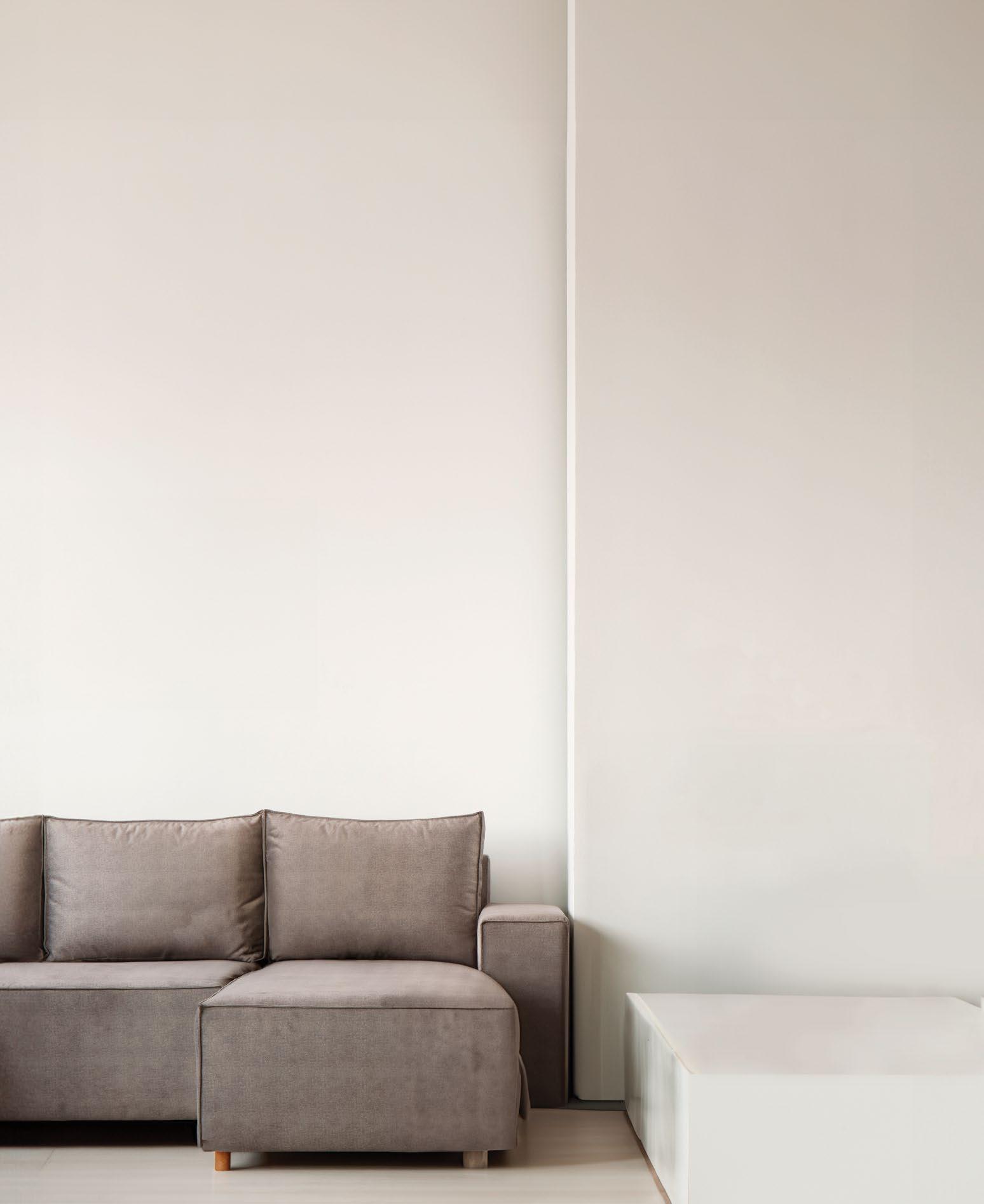



Reimagine your room in 20 seconds
Thinking of a room makeover?
Visualise the transformation with AI reDESIGN tool.

